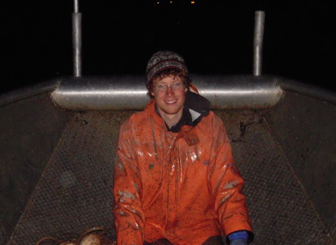|
Bertness Lab |  |
| Coastal Ecology and Conservation at Brown University |
| Overview |
| Consumer control |
| Human impacts |
| Foundation species |
| Climate change impacts |
| Historical ecology |
| Mark Bertness |
| Tyler Coverdale |
| Eric Axelman |
| Steph Yin |
| Caitlin Brisson |
| Eric Young |
| Xiao Li |
| Lab Alumni |
Undergraduate Student A.B. Religious Studies, Brown University (Expected 2013) Eric_Young@Brown.edu |
 |
I am working to elucidate and quantify the process of New England marsh loss that has already been broadly described by the Bertness lab. Over the past four decades, recreational fishing on Cape Cod has depleted top predators, leading to the release of the herbivorous marsh crab Sesarma from predator control. At high densities, Sesarma can denude marsh creek banks of cordgrass, which can lead to dramatic erosion and marsh loss. I am using surveys, burrowing and erosion experiments, and GIS data to examine the mechanism of this marsh loss. Sesarma preferentially burrows in creek bank peat substrate, and its burrowing increases peat’s vulnerability to sediment erosion and continued burrowing. The eventual result is creek bank slumping and calving, and the widening of marsh creeks and basins. Newly exposed peat substrate and cordgrass become significantly more susceptible to intense burrowing and herbivory, meaning an entire marsh is vulnerable to die-off and erosion. In recent decades, the process has led to the rapid loss of centuries of marsh accretion and the valuable ecosystem services salt marshes provide. |
|